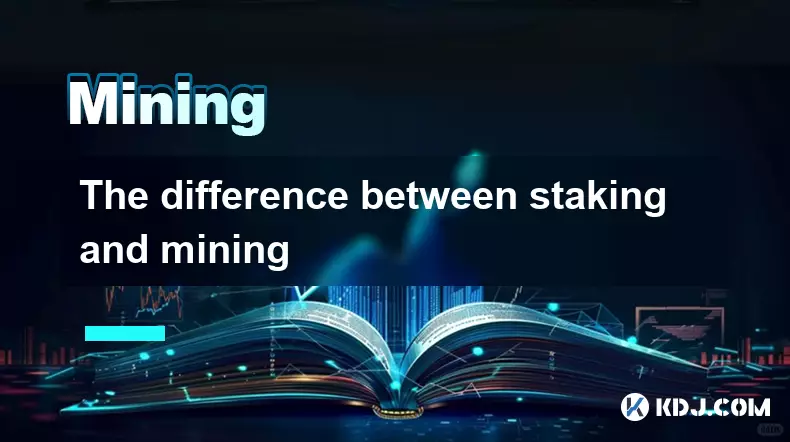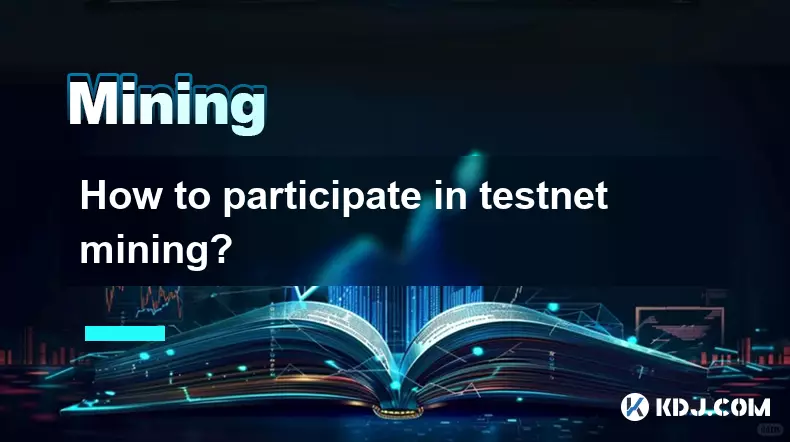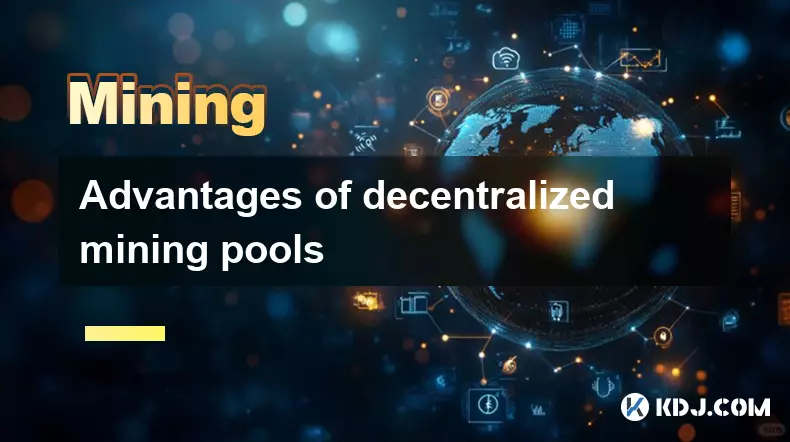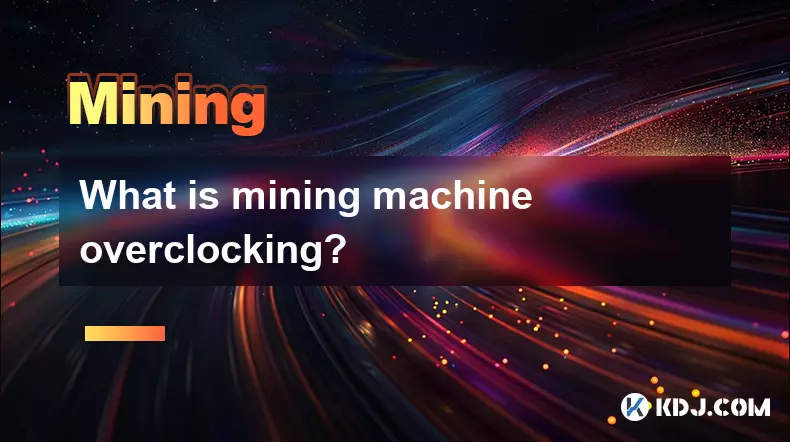-
 bitcoin
bitcoin $122025.899241 USD
-2.12% -
 ethereum
ethereum $4488.068729 USD
-4.11% -
 bnb
bnb $1315.348019 USD
8.65% -
 tether
tether $1.000457 USD
0.03% -
 xrp
xrp $2.875326 USD
-3.69% -
 solana
solana $222.043604 USD
-4.07% -
 usd-coin
usd-coin $0.999682 USD
0.00% -
 dogecoin
dogecoin $0.249887 USD
-5.62% -
 tron
tron $0.337379 USD
-2.59% -
 cardano
cardano $0.827763 USD
-5.06% -
 hyperliquid
hyperliquid $45.774531 USD
-2.43% -
 chainlink
chainlink $22.079309 USD
-5.87% -
 ethena-usde
ethena-usde $1.000156 USD
0.02% -
 sui
sui $3.482566 USD
-3.57% -
 stellar
stellar $0.386982 USD
-4.92%
How does Bitcoin mining difficulty adjust?
Bitcoin mining difficulty adjusts every 2016 blocks (~2 weeks) to maintain a steady 10-minute block time, ensuring network stability and security.
Jul 25, 2025 at 10:14 am

Understanding Bitcoin Mining Difficulty
Bitcoin mining difficulty is a crucial mechanism that ensures the stability and security of the Bitcoin network. It refers to how hard it is to find a new block in the blockchain. The difficulty adjusts to maintain a consistent block time of approximately 10 minutes per block, regardless of how much total computational power (hashrate) is being applied to the network. Without this adjustment, faster hardware or more miners could drastically shorten the time between blocks, destabilizing the network's predictability.
The difficulty is encoded as a 32-bit integer in the block header and is recalculated every 2016 blocks. This number represents the target threshold that a block's hash must meet or be below to be considered valid. The lower the target, the higher the difficulty, meaning more computational work is required to find a valid hash.
How Often Does Difficulty Adjust?
The Bitcoin network recalculates mining difficulty every 2016 blocks, which is roughly every two weeks given the 10-minute average block time. This interval is hardcoded into the Bitcoin protocol and ensures that adjustments are frequent enough to respond to changes in network hashrate, but not so frequent that they cause instability.
The adjustment is based on the actual time it took to mine the previous 2016 blocks compared to the expected time of 20,160 minutes (2 weeks). If the actual time is shorter, difficulty increases. If it's longer, difficulty decreases. This feedback loop keeps block production steady.
Formula Behind Difficulty Adjustment
The new difficulty is calculated using the following formula:
new_difficulty = old_difficulty × (actual_time_for_2016_blocks / 20160 minutes)However, there are limits to how much the difficulty can change in a single adjustment period. The Bitcoin protocol enforces a maximum change of 4x (300%) or 0.25x (−75%) per adjustment. This cap prevents extreme swings in difficulty due to sudden changes in hashrate, such as large mining farms coming online or shutting down.
For example, if the last 2016 blocks were mined in 10,080 minutes (1 week), the actual time is half the expected time. The difficulty would double, assuming it doesn’t exceed the 4x cap. Conversely, if it took 30,240 minutes (3 weeks), the difficulty would be reduced to two-thirds of the previous level, again respecting the 0.25x floor.
Step-by-Step Process of Difficulty Adjustment
- Every full node in the Bitcoin network tracks the timestamp of each block in the last 2016-block window
- When a node receives the 2016th block after the last adjustment, it calculates the total time difference between the first and last block in that window
- The node computes the ratio of actual time to expected time (20,160 minutes)
- It multiplies the previous difficulty by this ratio
- The result is clamped to ensure it does not increase by more than 4 times or decrease by more than 4 times
- The new difficulty target is encoded into the block header of the next block, and all miners must use this new target for their proof-of-work calculations
This process is fully decentralized and automatic. No central authority decides the difficulty; every node independently performs the same calculation and reaches consensus on the correct value. If a miner tries to use an outdated or incorrect difficulty, their block will be rejected by the network.
Role of Timestamps in Difficulty Adjustment
Block timestamps play a critical role in calculating difficulty. Each block header contains a timestamp that must meet specific rules: it must be greater than the median of the past 11 blocks and less than the network-adjusted time plus 2 hours. These rules prevent miners from manipulating timestamps to artificially influence future difficulty adjustments.
However, because timestamps are set by miners and can be slightly inaccurate, the system relies on the aggregate behavior of the network. Over 2016 blocks, minor timestamp variations average out, ensuring the difficulty adjustment remains robust. In rare cases, if many miners collude to manipulate timestamps, it could skew the adjustment, but game theory and economic incentives discourage such behavior.
Impact of Hashrate Fluctuations on Difficulty
When large mining operations come online—such as new data centers in regions with cheap electricity—the network hashrate spikes. This leads to blocks being found faster than 10 minutes on average. After the next 2016-block window, the difficulty will increase significantly to compensate. Conversely, during events like regulatory crackdowns or power outages in mining-heavy regions, hashrate can drop sharply, causing blocks to take longer. The next difficulty adjustment will then decrease, making mining easier again.
For example, after China banned cryptocurrency mining in 2021, hashrate dropped by over 50%. The subsequent difficulty adjustment reduced the target by around 28%, one of the largest drops in Bitcoin’s history, allowing remaining miners to continue profitably.
How Miners Adapt to Difficulty Changes
Miners must constantly monitor difficulty adjustments to remain profitable. When difficulty increases, the same hardware produces fewer rewards per unit of time. Some miners may shut down older ASICs that become unprofitable. Others may relocate to areas with lower electricity costs.
Mining pools help individual miners smooth out variance by combining hashrate and distributing rewards proportionally. Even with difficulty changes, pool participants receive steady payouts based on their contributed work. Miners also use tools like difficulty reset calculators and profitability estimators to anticipate changes and optimize operations.
Frequently Asked Questions
Q: Can difficulty adjust more than once every 2016 blocks?No, the Bitcoin protocol only allows difficulty adjustments every 2016 blocks. Intermediate blocks do not trigger recalculations, even if hashrate changes dramatically in the short term.
Q: What happens if the network hashrate drops to zero?If no miners are active, blocks stop being produced. However, after a long delay (exceeding several difficulty epochs), the difficulty would eventually drop to the minimum allowed level, making it easier for any returning miner to restart the network.
Q: Is difficulty the same across all Bitcoin nodes?Yes, all fully validating nodes compute the same difficulty value using the same 2016-block window and formula. This ensures consensus across the network.
Q: How is the initial mining difficulty determined?The genesis block used a hardcoded initial difficulty. Since then, every adjustment has been based on the prior 2016 blocks, creating a continuous chain of recalculations from block 1 to the present.
Disclaimer:info@kdj.com
The information provided is not trading advice. kdj.com does not assume any responsibility for any investments made based on the information provided in this article. Cryptocurrencies are highly volatile and it is highly recommended that you invest with caution after thorough research!
If you believe that the content used on this website infringes your copyright, please contact us immediately (info@kdj.com) and we will delete it promptly.
- BlockDAG, DOGE, HYPE Sponsorship: Crypto Trends Shaping 2025
- 2025-10-01 00:25:13
- Deutsche Börse and Circle: A StableCoin Adoption Powerhouse in Europe
- 2025-10-01 00:25:13
- BlockDAG's Presale Buzz: Is It the Crypto to Watch in October 2025?
- 2025-10-01 00:30:13
- Bitcoin, Crypto, and IQ: When Genius Meets Digital Gold?
- 2025-10-01 00:30:13
- Stablecoins, American Innovation, and Wallet Tokens: The Next Frontier
- 2025-10-01 00:35:12
- NBU, Coins, and Crypto in Ukraine: A New Yorker's Take
- 2025-10-01 00:45:14
Related knowledge

The difference between staking and mining
Sep 24,2025 at 05:18am
Understanding Staking in the Cryptocurrency Ecosystem1. Staking involves holding funds in a cryptocurrency wallet to support the operations of a block...

How to participate in testnet mining?
Sep 22,2025 at 09:18am
Understanding Testnet Mining in the Crypto Ecosystem1. Testnet mining is a method used by blockchain developers to simulate real-world conditions on a...

How to dispose of abandoned mining machines?
Sep 19,2025 at 08:19pm
Assessing the Condition of Abandoned Mining Rigs1. Begin by inspecting each mining machine for visible damage, corrosion, or missing components. Machi...

How to identify high-quality mining pools?
Sep 21,2025 at 03:19pm
Reputation and Track Record1. A mining pool’s reputation is built over time through consistent performance and transparency. Pools that have operated ...

Advantages of decentralized mining pools
Sep 20,2025 at 04:36pm
Enhanced Security and Resistance to Censorship1. Decentralized mining pools operate on blockchain-based smart contracts, eliminating the need for a ce...

What is mining machine overclocking?
Sep 21,2025 at 07:19pm
Understanding Mining Machine Overclocking1. Mining machine overclocking refers to the process of increasing the operating frequency of a cryptocurrenc...

The difference between staking and mining
Sep 24,2025 at 05:18am
Understanding Staking in the Cryptocurrency Ecosystem1. Staking involves holding funds in a cryptocurrency wallet to support the operations of a block...

How to participate in testnet mining?
Sep 22,2025 at 09:18am
Understanding Testnet Mining in the Crypto Ecosystem1. Testnet mining is a method used by blockchain developers to simulate real-world conditions on a...

How to dispose of abandoned mining machines?
Sep 19,2025 at 08:19pm
Assessing the Condition of Abandoned Mining Rigs1. Begin by inspecting each mining machine for visible damage, corrosion, or missing components. Machi...

How to identify high-quality mining pools?
Sep 21,2025 at 03:19pm
Reputation and Track Record1. A mining pool’s reputation is built over time through consistent performance and transparency. Pools that have operated ...

Advantages of decentralized mining pools
Sep 20,2025 at 04:36pm
Enhanced Security and Resistance to Censorship1. Decentralized mining pools operate on blockchain-based smart contracts, eliminating the need for a ce...

What is mining machine overclocking?
Sep 21,2025 at 07:19pm
Understanding Mining Machine Overclocking1. Mining machine overclocking refers to the process of increasing the operating frequency of a cryptocurrenc...
See all articles










































































